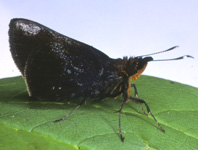Abstract
Partial life histories of 24 Hesperiinae incertae sedis that feed on Dicotyledons are described and illustrated. The genera dealt with are: Acada, Acleros, Andronymus, Fresna, Gorgyra, Melphinyet, Meza, Paronymus, Parosmodes, Platylesches, and Teniorhinus. The food plants of Gorgyra (mainly Connaraceae), Melphinyet (Euphorbiaceae) and Platylesches (Chrysobalanaceae) stand out as clearly distinct from those of the other six genera, which share one or two food plant families with each other. Thus four genera include Fabaceae in their food plants, two include Sapindaceae, two include Combretaceae, and Andronymus includes all three. Ova are only reported for five genera, but they do point to some significant differences: Gorgyra, Parosmodes and Platylesches are different from each other, and different from Acleros and Andronymus. The features of the caterpillars do not indicate clear patterns. The pupal shelters point to Parosmodes and Melphinyet showing some affinity and certainly differ from all others. Acleros and Andronymus have similar pupal shelters, and in common with Meza (dicotyledon-feeding species) and Fresna, the pupal chamber is not closed and the pupa rests on the leaf upper surface. The pupae of Gorgyra differ from all others. The pupae of Acleros and Andronymus have their colouring in common, probably reflecting their very similar pupal shelters. Similarly the pupae and shelters of Meza (dicotyledon-feeding species) and Fresna seem analogous. The other pupae, hidden in their shelters are less differentiated, although the completely wax-free shelter of Acada is superficially different. We conclude that the likeliest scenario is that in the Afrotropical Region members of the Hesperiinae incertae sedis have made the switch from monocotyledons to dicotyledons several times, and then radiated.

